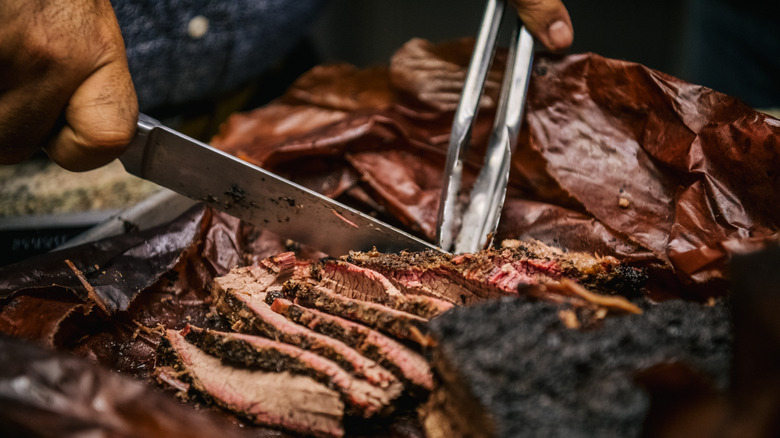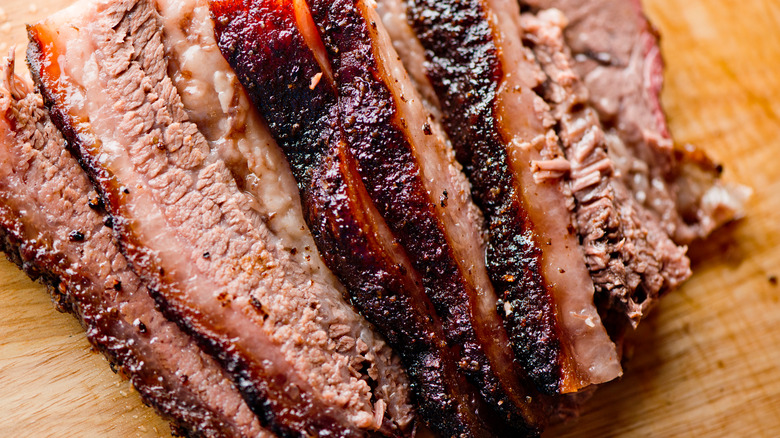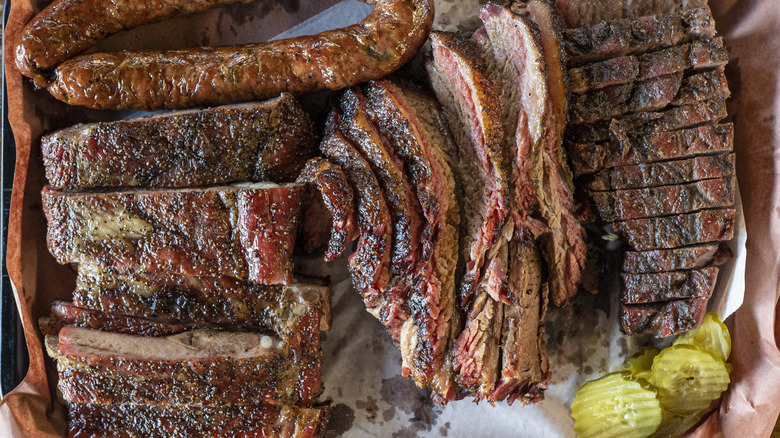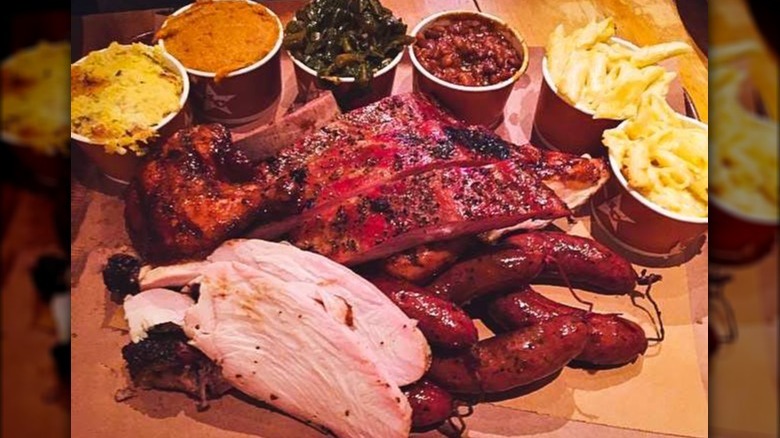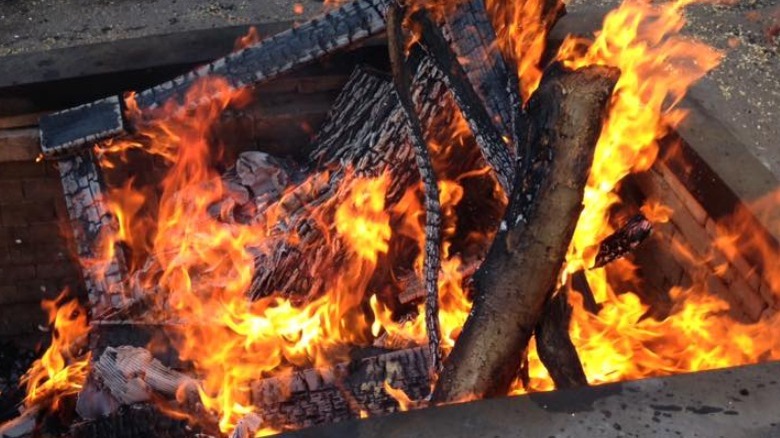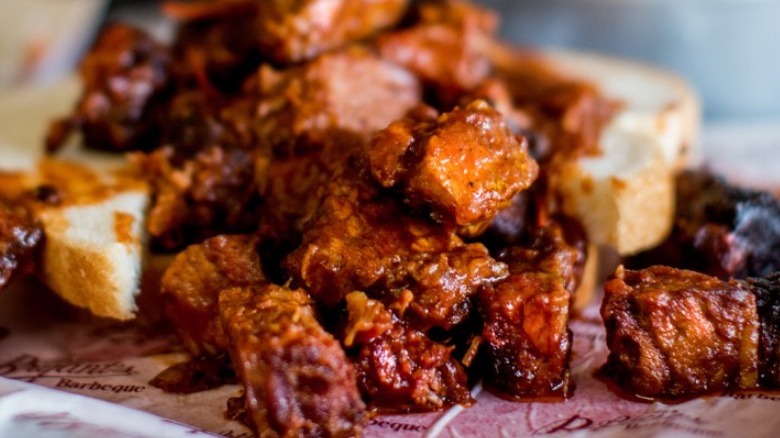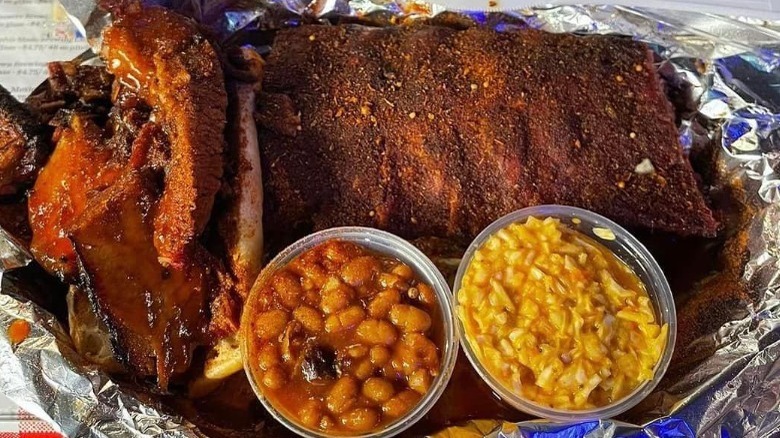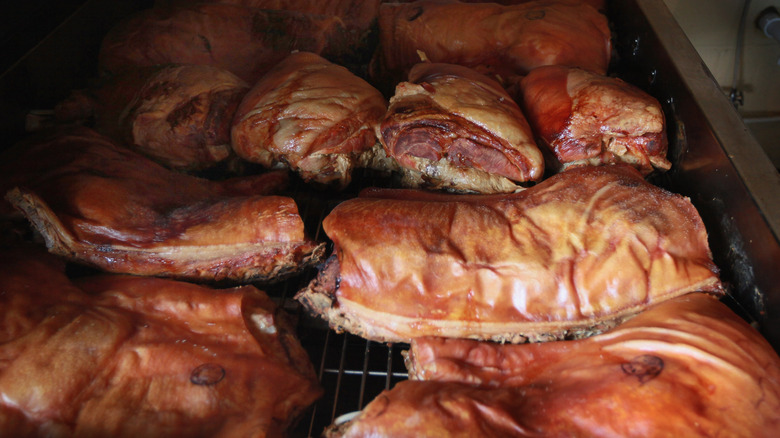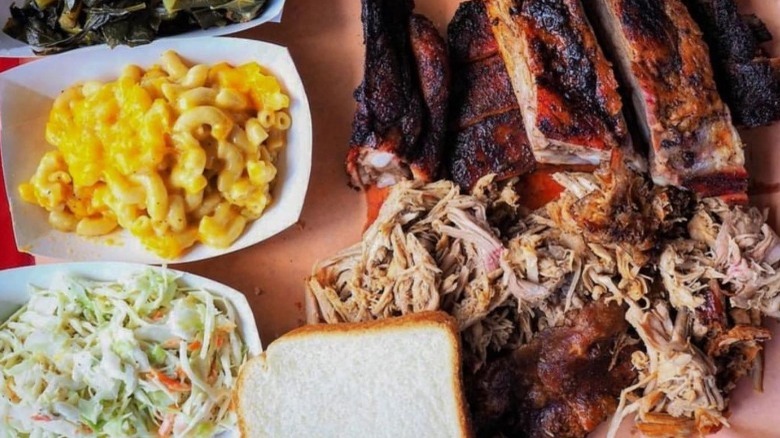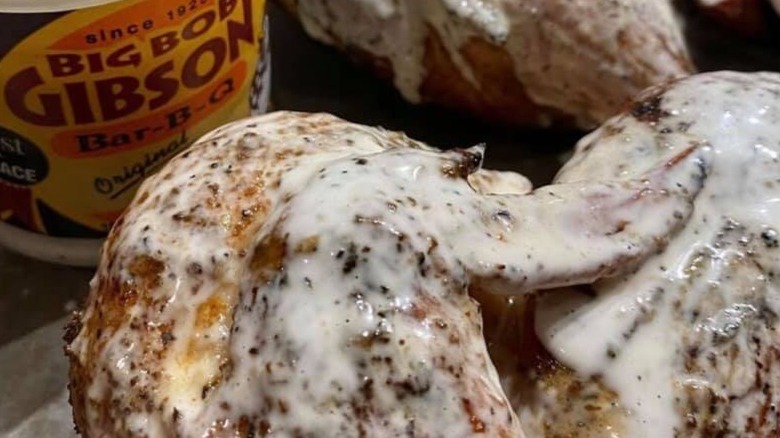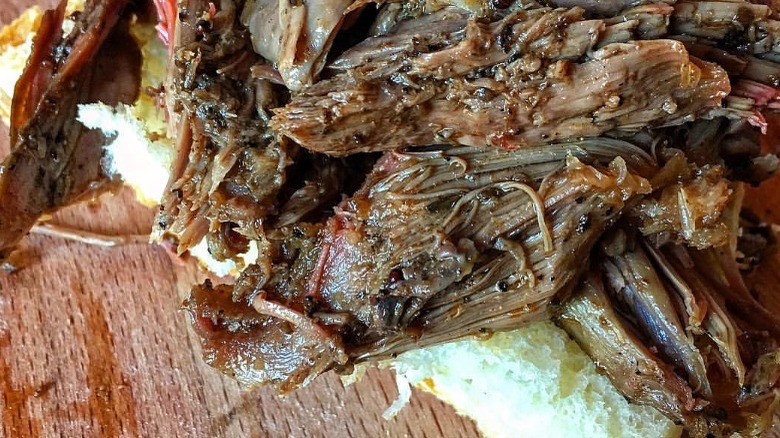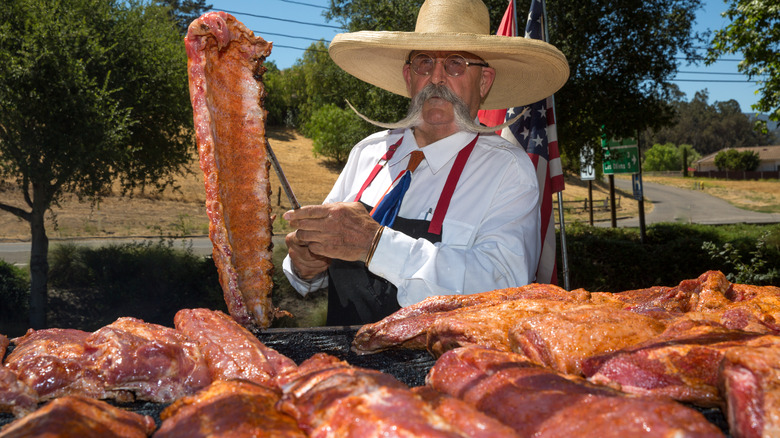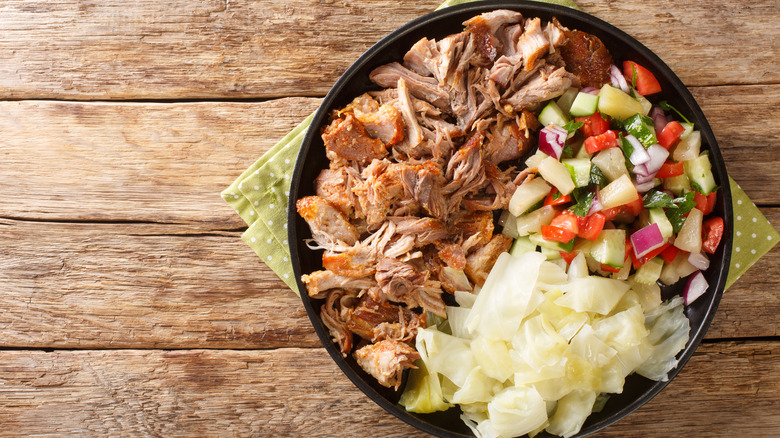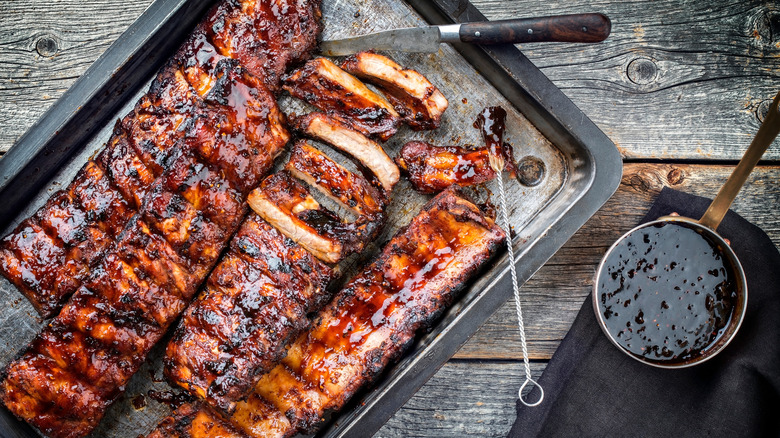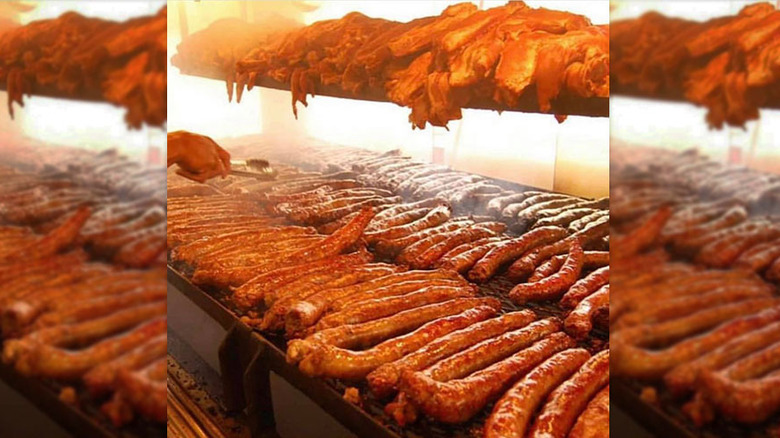America's Regional Barbecues, Explained
Meat and fire — has there ever been a more tempting duo? Barbecue has a long tradition in the United States, with influences from across the globe. Sauces and spice rubs characterize certain regions, as do side dishes and eating rituals. But at its core, barbecue is meat that's been cooked low and slow, requiring hours of close attention from a discerning pitmaster.
Barbecue in America dates back to colonial times. The term appears in the 1672 published writings of John Lederer, following his travels in the American southeast. While the American South is closely tied to barbecue traditions, migration and global influences created other barbecue styles in regions as far-flung as California and Hawaii.
Let's take a closer look at the history and characteristics of American barbecue styles, from Texas to Kansas City, from the Carolinas to the Pacific. While each style continues to evolve, especially as barbecue becomes increasingly competitive, many pitmasters take pride in hewing close to their region's roots.
Central Texas
The state of Texas is largely synonymous with barbecue, and the term "Texas barbecue" generally refers to the Central Texas style, popularized by joints in Austin and surrounding areas. "You see [Central Texas-style barbecue] in Seattle, Phoenix, and all over," Texas Monthly BBQ editor Daniel Vaughn told First We Feast. "In terms of rituals, you're going to order meat by the pound at a counter. You're going to see the person cut it, and the meat will be served on butcher paper. Seasoning is minimal, and sauce will be on the side (a lot of people mistake that for no sauce)."
Because of its cattle industry, Texas barbecue centers on beef, especially brisket. After the Civil War, the South's economy was largely destroyed, but Texas still had its beef — and a lot of it. As a result, Czech and German immigrants opened butcher shops all over the state. Without refrigeration, these butcher shops became the first barbecue joints, selling smoked meats that might have otherwise gone bad.
Central Texas barbecue also offers pork spare ribs (as opposed to baby-back ribs) and smoked sausage. "More than any other style of barbecue in the U.S.," Vaughn says, "Central Texas is known for its homemade links. The best are juicy, smoky, and peppery ... and provide what I like to call a good 'snap.'" The centrality of sausage can also be credited to German and Czech immigrants.
East Texas
Though Central Texas looms the largest nationwide, the East Texas-style of barbecue was likely the state's first. During the era of slave migration, "many African Americans came here and brought their traditions with them, which is why this region is more akin to the rest of Southern barbecue," Vaughn says.
Though Southern barbecue centers around pork, East Texans preserved the cooking style but substituted the more plentiful and cheaper beef. According to "Cornbread Nation 2: The United States of Barbecue," if the beef isn't falling off the bone, this region doesn't consider it done. "Need no teef to eat my beef" is a popular slogan in the area. Even the pork ribs are cooked until a bit more tender than in Central Texas.
Homemade sauces are an important component of East Texas barbecue. A thin tomato-based sauce with a slight vinegar kick coats the ribs here, and saucy chopped beef or pulled pork sandwiches are popular. You'll also find smoked chicken and boudin, a Cajun-influenced import from Louisiana.
If you're in the southeast region near Beaumont or Port Arthur, seek the all-beef sausage better known as links. Spiced more aggressively than Central Texas sausage, links are loaded with chili powder, paprika, and garlic. With their high fat-to-meat ratio, they've been nicknamed "greaseballs" — but always said with love.
Hill Country
Texas's Hill Country, the area west of Austin, is known for cooking with direct heat. Rather than smoking the meat, wood (usually mesquite) is burned down to coals that are then shoveled into large metal boxes called flat pits.
Also known as Cowboy Style, Hill Country cooking is reminiscent of cooking over a trench and produces a distinct flavor. Because this isn't low-and-slow cooking, the meat isn't imbued with the flavor of indirect wood smoke. Rather, the meat captures the smoke that arises as fat drips to the fire below. While Hill Country meats aren't as juicy as in other Texas styles, thinner cuts like ribs, chops, sausage, half-chickens, and pork steaks are delicious when cooked this way. And no need to worry — you'll still find brisket.
Because Cowboy Style barbecue requires the space, cost, and expertise of maintaining two fires, a decreasing number of restaurants offer it. However, you can find this special barbecue style at community events throughout the area.
South Texas
The heart of the South Texas-style is barbacoa, the barbecue style of Mexico. After all, this part of the state used to be Mexico before it declared independence and was later annexed by the U.S. Barbacoa is an ancient practice in which meat is cooked underground, or en pozo. Whole beef heads (cabeza) spend about 12 hours in an earthen pit until the meat is fall-apart tender.
Traditional barbacoa (not Chipotle's) is almost entirely absent from commercial barbecue. The only restaurant cooking the traditional way is Vera's Backyard Bar-B-Que in Brownsville, where barbacoa is available Friday, Saturday, and Sunday mornings. At Vera's, a fire is lit in a brick-lined pit and burned down to coals. The pit is then lined with agave leaves, the beef heads are lowered, and the pit is lidded until the meat is ready.
At other establishments, beef head, cheek, or tongue is wrapped and steamed in a giant bain-marie or braised in the oven. The Aztec word "tatema" describes barbacoa cooked in the ground with wood coals as opposed to steamed in this manner.
Fajitas, mollejas (beef sweetbreads), and cabrito (young goat) are also excellent finds in the area.
Kansas City
Henry Perry is credited with starting Kansas City's barbecue tradition known for dry-rubbed meats slow-smoked over wood and served with a thick tomato-based sauce. Around 1908, Perry opened an alley stand in the Garment District. He moved locations several times, but wherever he served, customers paid 25 cents for smoked meat with a harsh peppery sauce. Typical of the times, Perry's menu included beef, possum, woodchuck, and raccoon.
Throughout the roaring '20s, Count Basie, Mary Lou Williams, and Charlie Parker all loved Perry's food. One of Perry's acolytes, Arthur Bryant, helped to popularize Kansas City barbecue nationwide. Bryant mellowed Perry's sauce to make it more palatable. In a 1972 Playboy article, journalist and KC native Calvin Trillin called Arthur Bryant's Barbeque the best restaurant in the world. Trillin wrote, "the main course at Bryant's, as far as I'm concerned, is something that is given away free — the burned edges of the brisket. The counter-man just pushes them over to the side, and anyone who wants them helps himself. I dream of those burned edges."
Burnt ends are now the star of Kansas City 'cue, along with pork, brisket, beef ribs, smoked chicken, and turkey — even lamb and fish occasionally find their way to the smoker.
Memphis
Like many Southern barbecue cities, Memphis is a pork town, specifically pulled pork, ribs, and pork shoulder. And because Memphis is also a port town, cooks in the city had access to a variety of ingredients like molasses and spices.
You can have Memphis barbecue either dry or wet. Dry spice rubs containing salt, pepper, onion, garlic, and brown sugar are a restaurant's point of pride and remain a closely held secret. Wet barbecue, mopped with sauce, balances warm spices like chili pepper and paprika with a tangy tomato base. Legendary rib joint Charlie Verdos' Rendezvous swears by the dry rub, while Interstate Barbecue is famous for its sauce. In addition to pork, pitmasters smoke beef, sausage, chicken, and even bologna.
Memphis is the birthplace of several barbecue creations. In the 1950s, Coletta's introduced barbecue pizza, and Graceland's own Elvis Presley was said to be a fan. Barbecue spaghetti, or pulled pork and marinara over pasta, can be sampled at The Bar-B-Que Shop and other restaurants across town. You might also see menus with barbecue nachos, because tortilla chips make a terrific vehicle for pulled pork, tangy barbecue sauce, and melted cheese sauce.
North Carolina
Within North Carolina, you'll find two main barbecue styles: Eastern and Lexington (or Piedmont) styles. The Eastern style is the older of the two and focuses on whole-hog cooking, with the popular saying, "every part of the hog but the squeal." Eastern-style barbecue comes with a thin lemon or vinegar pepper-based sauce, without any tomatoes.
Eastern-style barbecue originated with the Croatan Indians who would use a framework of sticks called a "barbacoa" to cook meat over a fire, a practice also used by that the Spanish in the Caribbean. John Shelton Reed, co-author of "Holy Smoke: The Big Book of North Carolina Barbecue," told Our State that it's possible the Caribbean cooking tradition came to the mainland via the slave trade and refugees who sought asylum in America during the Haitian Revolution (1791-1804).
By contrast, the Piedmont style emerged during the first World War. Reed says that five men of German descent, nostalgic for a pork dish from Bavaria, adapted the Eastern style by serving pork shoulder with a vinegar dip that introduced ketchup. While ketchup adds sweetness and color to the sauce, it does not add thickening. All North Carolina barbecue sauces are thin, vinegar-based sauces.
South Carolina
South Carolina barbecue shares many qualities with its neighbor to the north: it centers on pork, arises from the same historical tradition, and according to BBQ Hub, has two regional varieties, Pee Dee and Midlands.
In the upper northeast quarter of the state known as the Pee Dee region, whole hogs are smoked for about 12 hours over open pits with heat from glowing hardwood coals. The hogs remain skin-side-up until they are flipped and sauced with the region's signature blend of vinegar, salt, black pepper, and red pepper. The pork is pulled and often served with white bread, coleslaw, and beans. The Pee Dee region is also known for rice dishes perloo and chicken bog.
The eight counties surrounding Columbia are known as the Midlands area, where the most distinguishing barbecue characteristic is the bright yellow mustard sauce. The gold-colored sauce is sweetened with brown sugar or honey and gets its tang from cider vinegar and black pepper. While some Midlands restaurants cook whole hogs, pork shoulder and ham are more common, with the cuts chopped into chunks or pulled into long shreds. Hash and rice, the region's signature side dish, is a barbecue stew akin to burgoo or Brunswick stew.
You can find four sauces across the Palmetto State, but the thin tomato and thick tomato sauces are borrowed from other regions.
Alabama
Alabama lacks a coherent barbecue identity. Nick Pihakis, the partial namesake of Alabama-based mini-chain Jim 'N Nick's, explained to Eater that restaurants in southeastern Alabama use a mustard-based sauce, while around Birmingham, it's a tomato-based sauce. Pihakis and his father exemplify the significant role Greek immigrants have had in developing Alabama barbecue restaurants.
In Decatur, Big Bob Gibson introduced the tangy, peppery white sauce that is sometimes viewed as the state's signature. Gibson's sauce derives from Carolina-style vinegar sauce. Chris Lilly, fourth-generation pitmaster, told Southern Living that Robert "Big Bob" Gibson "added mayo to the base to keep the chickens from drying out while he hung out in his backyard, waiting for his friends."
Alabama's barbecue history has been closely intertwined with its racial politics, as an essay by Mark A. Johnson outlines. From the early years of statehood, political barbecue became an important tradition. In the late 1800s, clubs made barbecues fundamental elements of their meetings. During the Civil Rights era, restaurants like Ollie's Barbecue became a flashpoint of Jim Crow policies.
Most Alabama barbecue restaurants focus on pork, specifically pork shoulder and butt. Chicken and wild game are also commonly smoked over an open pit with hickory wood. Any of these meats make a tasty filling for barbecue-stuffed baked potatoes.
Kentucky
Kentucky's most distinct barbecue dish is mutton that has been basted while smoking with a Worcestershire-based dip. As BBQ Hub explains, this savory sauce contains vinegar, black pepper, and allspice. While mutton is concentrated around the town of Owensboro, pulled or chopped pork made from pork shoulder or Boston butt is more commonly found in the state. Pitmasters burn wood, usually hickory, and shovel the coals into concrete masonry pits.
According to Wes Berry, author of "The Kentucky Barbecue Book," sauces vary county by county. For example, vinegar and cayenne pepper are the base of the Hickman County sauce, while Union and Henderson counties favor a savory Worcestershire-based dip. McCraken County sauces tend to have a bite of vinegar combined with chili powder. Monroe County-style barbecue takes frozen bone-in Boston butts, saws them into slices, and cooks them over hot coals for about 45 minutes. As these slices are quickly imbued with smoke, they are basted with a dip of vinegar, lard, butter, cayenne, black pepper, and salt.
While some Kentucky counties have micro-preferences like a thick sauce or barbecue on toast, the Louisville and Lexington areas have become barbecue melting pots drawing from Memphis, Texas, and western Kentucky styles.
Santa Maria
Santa Maria is a town in Santa Barbara County, on California's Central Coast. Now known for its rolling vineyards, Santa Maria was historically a cattle town.
As explained by Texas Monthly, the customary way to cut beef in the 1950s was to grind the triangular piece of bottom sirloin. Bob Schutz, a one-armed butcher at the local Safeway, essentially created a new cut of beef that he cooked on a rotisserie and marketed as tri-tip. When he later opened the Santa Maria Market, tri-tip was his signature cut.
But Santa Maria barbecue has deeper roots than Schutz's cut of beef. According to R.H. Tesene, author of "Santa Maria Style Barbecue," this style originated in 1920 when the Santa Maria Club was founded and a barbecue pit was installed behind headquarters.
The Santa Maria Club and later the Elks Lodge became known for their public parties, especially the barbecued prime rib. When prime rib became too expensive, these organizations began cooking large slabs of top sirloin. While tri-tip remains popular for backyard barbecues, it's more economical for large operations to use the thick top blocks of sirloin.
The signature Santa Maria seasoning is garlic powder, black pepper, and salt. Its signature accompaniment is pinquito beans, a variety of pinto beans unique to the area. Buttered French bread and mild chunky salsa are also traditional sides.
Hawaiian
Hawaii's ethnic diversity manifests in its food. On any banquet table, you might find Korean-style ribs next to Portuguese bread. "Hawaiian-style foods," then, differ from traditional Hawaiian dishes such as poi. Modified over the years by colonialism and migration, the story of Hawaiian barbecue turns disparate influences into comforting to-go boxes. Starting in the 1880s, when sugar and pineapple became cash crops, plantation workers brought their lunch in bento boxes. These humble workday meals became the Hawaiian plate lunch we know today.
By contrast, kahlua pork derives from regal feasts. A whole hog seasoned with Hawaiian salt is cooked in an underground pit, flavored by the smoke from koa wood, lava rocks, and banana leaves. Today, an easier method is to take pork wrapped in ti leaves and slow cook it in a standard oven.
L&L Hawaiian BBQ first opened a drive-thru on Oahu in 1976, then in 1999 introduced its fare to the mainland. L&L largely defined what we now know as "Hawaiian BBQ," growing to over 200 franchise locations, often owned by immigrants.
St. Louis
St. Louis-style ribs are spare ribs that have been trimmed to a rectangular shape, removing the sternum, cartilage, and rib tips. These ribs are not usually slow-smoked but rather grilled and sauced, begging the question as to whether they should be included in this list. But since the USDA has officially recognized "Pork Ribs, St. Louis Style," so will we.
In the late 1980s, the USDA was standardizing meat labels, an undertaking called Institutional Meat Purchase Specifications (IMPS). When it came to the St. Louis cut, bureaucratic norms dictated that geographic references should not be used in labeling. "I happen to be an avid St. Louis Cardinal baseball team fan, and they had just defeated the San Francisco Giants in a playoff," Steve Olson, the original author, told St. Louis Today. "I told my boss that I was going to name the cut St. Louis Style... and if he didn't like that, he could find someone else to write the IMPS."
According to St. Louis magazine, the city consumes more barbecue sauce than any other American city. It's a sweet, tomato-based sauce that can be thick or thin, spicy or tangy. St. Louis is also known for barbecued pork steak, which is thinly sliced pork shoulder, as well as crispy snoots, or slow-cooked snouts.
Chicago
As food historian Peter Engler explained to Eater, the first barbecue restaurant in the Windy City opened in the 1930s. During the Great Migration, African Americans from the Mississippi Delta brought a style of smoking meat over direct heat and serving it with sweet sauce to Chicago's South Side. At the same time, Eastern European immigrants brought sausages and boiled meats to Chicago's North Side.
The city had become a butchery epicenter, favoring the rib tips that were often a discarded byproduct of the St. Louis-style rib described above. Rib tips remain popular today because they "are the perfect combination of what people crave in a rib and the fatty richness of bacon," says County Barbecue chef Erick Williams.
The most defining characteristic of Chicago-style barbecue is the aquarium smoker, first made by Avenue Metal in 1954. Chicago's harsh winters make cooking outside impractical, so the contraption (so named because it resembles a fish tank) enables pitmasters to smoke meat inside. But because these smokers are expensive to maintain, inconsistent, and labor-intensive, you'll only see them on the South Side and far West Side. On the North Side, rotisserie smokers spin racks over smoke produced by burning wood. However, because gas heats the mechanism, many South Side purists disapprove of this method.
